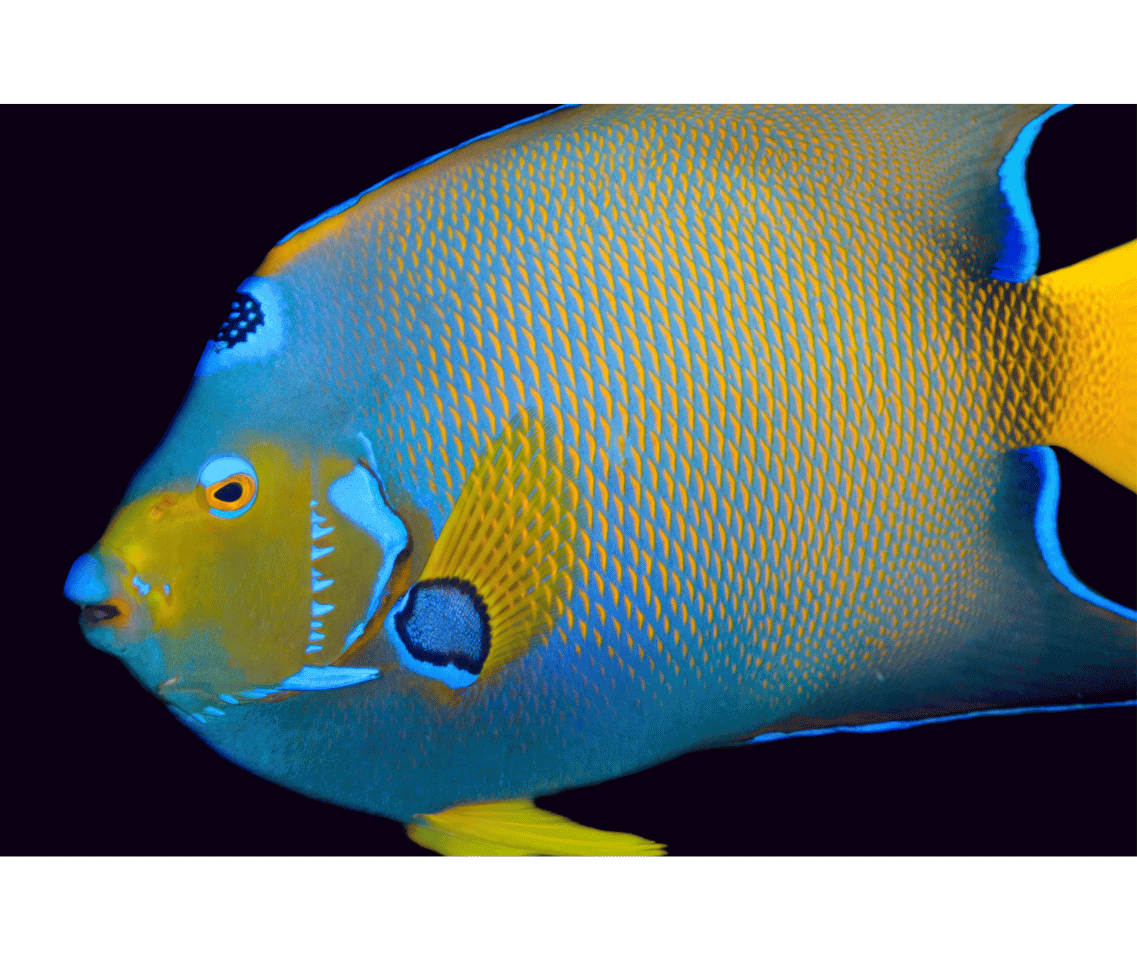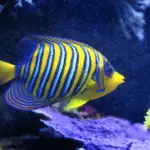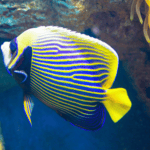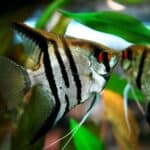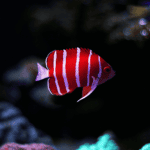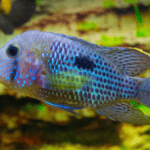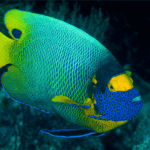Queen angelfish, scientifically known as Holacanthus ciliaris, are vibrantly colored and fascinating marine creatures native to the western Atlantic Ocean. Known for their distinctive bright blue and yellow hues and unique physical features, queen angelfish are a popular subject among marine biologists and aquarium enthusiasts alike. From their diverse diet to their remarkable life cycle, these captivating fish truly reign as queens of the underwater world.
Found primarily in the coral reefs and rocky shores of the western Atlantic Ocean, from Bermuda to Brazil, queen angelfish share their domain with numerous other marine species. Their vibrant colors serve as both camouflage and a warning sign to predators, signaling their unpalatability. As one of the largest angelfish species, queen angelfish showcase an intriguing mix of beauty, intelligence, and aggression, making them an ideal subject of both scientific study and admiration among aquarists.
Key Takeaways
- Queen angelfish are vibrantly colored reef-dwelling fish found primarily in the western Atlantic Ocean
- These fish exhibit unique physical features and behaviors, including a diverse diet and fascinating life cycle
- Their vibrant hues serve multiple purposes, including camouflage and warning signals to predators, enhancing their survival in their natural habitat.
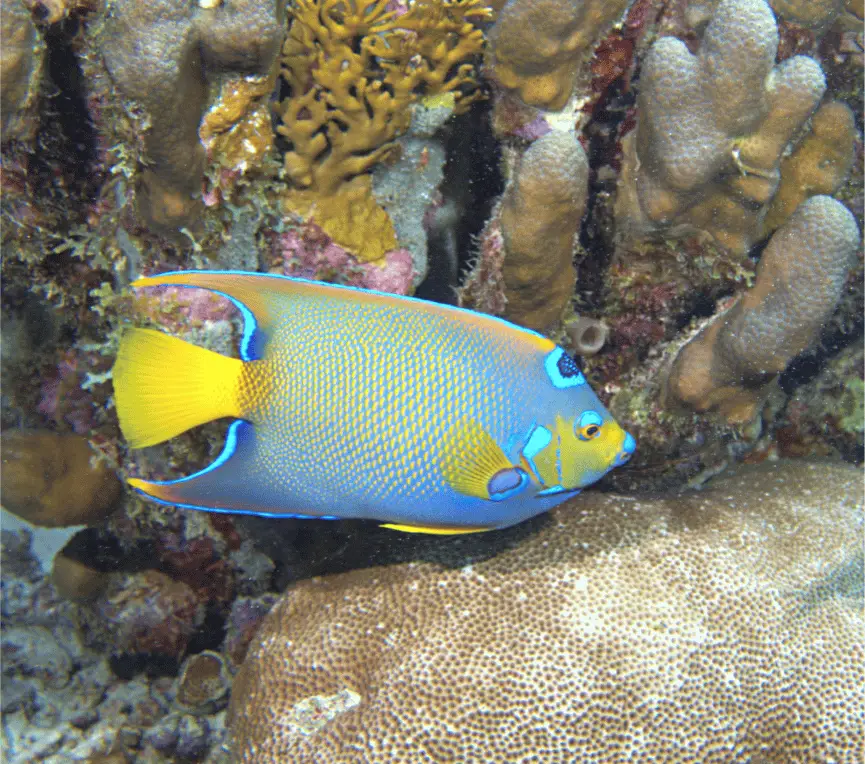
Habitat and Distribution
Coral Reefs and the Atlantic
Queen Angelfish are widely distributed throughout the marine environments of the western Atlantic Ocean. Their habitat consists primarily of coral reefs, both soft corals and hard corals, providing them with a diverse and rich ecosystem. Corals offer an abundance of food sources and shelter for the Queen Angelfish, making them essential to their survival.
In the Atlantic Ocean, they are often found near rocky outcrops, as well as sponges and gorgonians, which allow them to navigate and maintain their radiant colors beneath the ocean surface. The coral reefs play a vital role in their distribution, as they are attracted by the lush plant and animal life these ecosystems have to offer.
Florida, Bermuda, and the Caribbean
Queen Angelfish predominantly inhabit the warmer waters of the western Atlantic Ocean, including the Gulf of Mexico and the Caribbean Sea. They are most commonly found in the shallow waters of Florida, Bermuda, and the Caribbean islands. Although their range may vary seasonally or due to oceanic currents, these tropical locations are crucial for their overall habitat and distribution.
In the Florida and Bermuda regions, the Queen Angelfish are known to reside in reef environments with living corals, sea fans, and sponges. Meanwhile, the Caribbean Sea offers a rich variety of coral reefs, seagrass beds, and mangrove ecosystems, which play a significant role in maintaining their population.
As a result, our focus on conserving the habitats of these remarkable creatures is essential to ensure their long-term survival in the challenging marine environments they call home.
Related: Overview of Freshwater Angelfish
Physical Characteristics
As we dive into the physical characteristics of the Queen Angelfish, we find a vibrant and captivating species. Known for their majestic appearance, this species has a royal blue body contrasted with bright yellow tail and pectoral fins. The scales are iridescent, shimmering as they swim through the water.
Queen Angelfish also have a distinct “crown” on their forehead. This crown typically consists of a circular, electric blue ring, giving them their regal appearance. Unlike their close relative, the Blue Angelfish, Queen Angelfish have more dominant yellow hues in their fins and around their face.
The dorsal fin of the Queen Angelfish is long and continuous, stretching along the top of their body. This fin, coupled with the yellow pectoral fins, enable them to be strong swimmers and highly maneuverable in the water. Additionally, their sleek body shape allows them to glide effortlessly through their coral reef habitats.
One fascinating feature of the Queen Angelfish is their beak-like mouths. These specialized mouths are designed for grazing on sponges, algae, and tunicates that make up their diet. These beak-like mouths are an adaptation that helps them efficiently feed in their aquatic environment.
In summary, the Queen Angelfish boasts a unique and striking set of physical characteristics. The contrast of blue and yellow coloring, iridescent scales, distinguishable crown, and beak-like mouths emphasize their beauty and adaptability within their natural habitat.
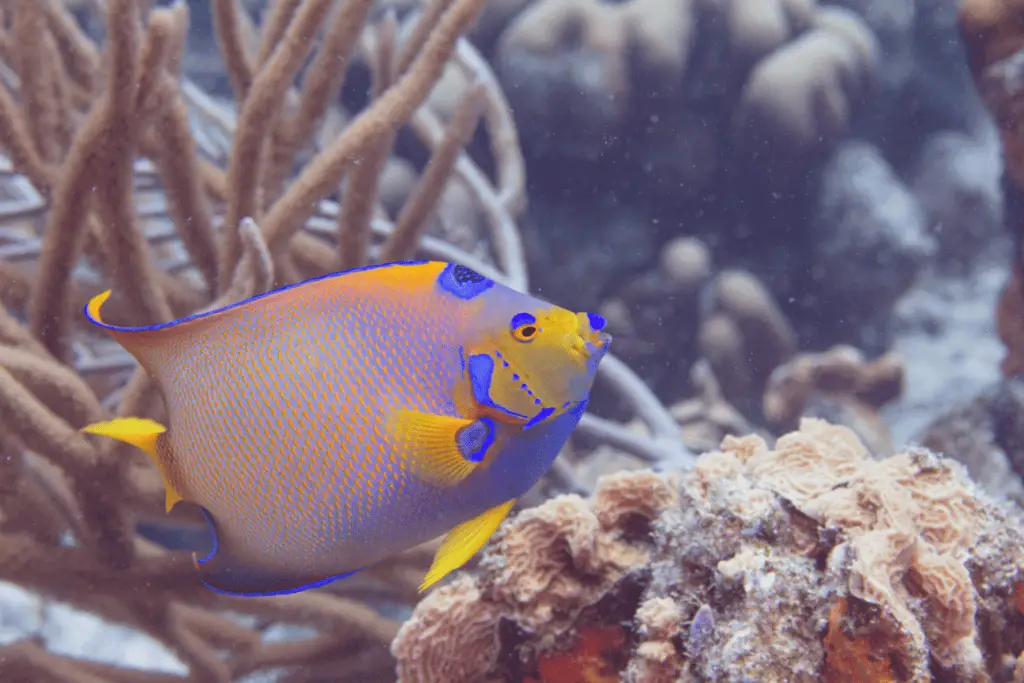
Diet and Feeding Habits
Algae and Invertebrates Diet
Queen Angelfish are well-known for their diverse diet. They primarily consume marine algae, filamentous algae, and sponges, which provide vital nutrients to help them thrive in their aquatic environment. Invertebrates such as parasites, jellyfish, and plankton also form a part of their diet.
As foragers, Queen Angelfish actively seek out various invertebrates including:
- Jellyfish: A potential source of protein for Queen Angelfish
- Parasites: Consuming parasites helps maintain a balanced ecosystem
- Tunicates: These filter feeders offer essential nutrients for the Queen Angelfish
Foraging and Eating Methods
Queen Angelfish are active foragers, and they use several strategies to find their preferred food sources. They are known to graze on filamentous algae throughout the day, which is essential for their overall well-being.
When it comes to invertebrates, Queen Angelfish use their strong jaws and specialized teeth to feed on sponges housing various microorganisms. While consuming these invertebrates, the fish also ingest parasites that may be residing on the sponge, helping to control their population.
Our understanding of the Queen Angelfish’s diet and feeding habits continues to grow, revealing the vast range of food they consume to ensure their survival in the wild. By consuming both algae and invertebrates, these remarkable fish contribute to the health and functioning of the coral reef ecosystem.
Life Cycle
Juvenile to Adult Phase
In the life of Queen Angelfish, the transition from the juvenile to adult phase is quite fascinating. As juveniles, their appearance differs significantly from their adult counterparts. The young Queen Angelfish are typically smaller, and their colors are more vibrant, often with blue or yellow spots and stripes. As they mature and grow in size, their coloration becomes more subdued, transitioning to the brilliant blue and yellow hues seen in adults.
The growth process of a juvenile Queen Angelfish may take up to 15 years before they reach their full adult size. Throughout this time, they gradually adapt to their surroundings and begin to establish territories within coral reefs. It’s important to note that these fish are known to be semi-aggressive and will defend their territories against any intruders vigorously.
Reproduction and Spawning
The reproduction process of Queen Angelfish is an intricate dance of synchronization and timing. They reproduce through a method called broadcast spawning, in which both the female and male release their eggs and sperm into the water column simultaneously. This process increases the likelihood of fertilization while also reducing the chances of predation. The larvae that hatch after a day or two are distributed across large areas by ocean currents, allowing the species to maintain genetic diversity and healthy populations.
During the spawning cycle, the adult fish synchronize their movements to ensure the successful release of their reproductive cells. This usually involves courtship rituals that help strengthen the bond between the mating partners, before the spawning event takes place at dusk or night.
Interestingly, Queen Angelfish can sometimes form hybrids with other closely related angelfish species. While rare, these instances can result in offspring that exhibit unique coloration patterns and an even broader range of habitats. This capacity to adapt and interbreed highlights the resilience of this fish species within their aquatic environments.
Overall, the life cycle of Queen Angelfish showcases their adaptability and the importance of each stage. From the vibrant juveniles to the striking adults, their journey through life is one filled with growth, territory establishment, and the fascinating synchronization of reproduction and spawning.
Subspecies and Hybrids
Holacanthus Bermudensis and Other Species
In the world of angelfish, we can find a variety of species and subspecies existing naturally within their respective habitats. One notable member of this family is the Holacanthus Bermudensis, commonly known as the Queen Angelfish. This vibrant and colorful species is often sought after in the aquarium trade due to its striking appearance, making it a highly desired addition to many marine tanks.
Another closely related species to the Queen Angelfish is the Townsend Angelfish, which is in fact a hybrid resulting from the interbreeding of Holacanthus Bermudensis and the equally impressive Butterflyfish (Chaetodon). The Guinean Angelfish is another species that shares similarities with the Queen Angelfish and can sometimes be found alongside it in its natural habitat.
Interbreeding and Genetic Mixes
When different species of angelfish share the same environment, interbreeding can occur, resulting in unique hybrids like the Townsend Angelfish. These hybrids often exhibit characteristics from both of their parent species, creating fascinating and beautiful offspring.
The emergence of hybrids in the wild is a natural phenomenon, albeit relatively rare. However, in the aquarium trade, deliberate efforts are sometimes made to produce new and exciting hybrid varieties, as they can be especially appealing to collectors and enthusiasts.
The possibility of interbreeding has raised concerns about the dilution of pure genetic lines for certain species, such as the Holacanthus Bermudensis. To tackle this issue, responsible breeders in the aquarium trade need to properly identify and isolate species when breeding, ensuring that the unique characteristics of each species are preserved for future generations.
In conclusion, the world of angelfish is diverse and fascinating, with an ever-evolving tapestry of species and hybrids waiting to be discovered. Whether it’s the brilliant Queen Angelfish or the rare Townsend Angelfish, these creatures never cease to captivate and enchant all who encounter them.
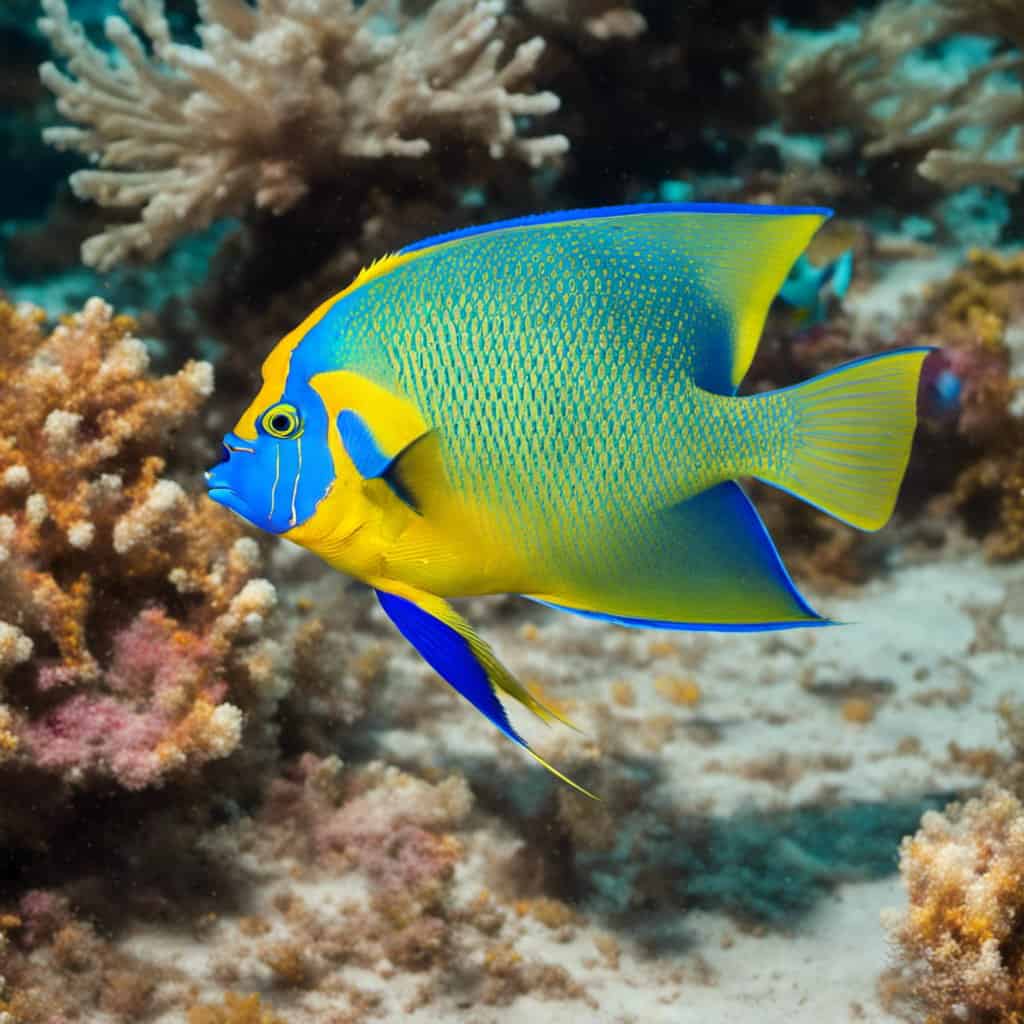
Threats and Conservation Status
We can confidently inform our readers that the Queen Angelfish (Holacanthus ciliaris) has a conservation status of Least Concern on the IUCN Red List. This indicates that the species is comparatively widespread and abundant. The population trend of Queen Angelfish is considered stable, meaning that there is no significant decline in their numbers. Our primary focus when discussing threats and conservation status will be on factors that could potentially harm or disrupt the species’ stability in the future.
However, it should be noted that this species may still face certain threats. In particular, Queen Angelfish are susceptible to ciguatera poisoning, which occurs due to the buildup of ciguatoxins in their tissue. These toxins are produced by harmful microscopic marine algae, and they enter the food chain when small fish feed on the algae. Larger fish, such as the Queen Angelfish, then ingest these toxins by consuming smaller fish. Ciguatera poisoning poses a potential risk for both the health of marine ecosystems and human consumers of contaminated fish.
The Queen Angelfish’s habitat, found in coral reefs, is also subject to various human-induced pressures. These include overfishing, habitat degradation, and the effects of climate change. To tackle these issues, it is essential to establish and enforce marine protected areas and fisheries management regulations.
In conclusion, while the Queen Angelfish’s conservation status is technically Least Concern and their population remains stable, we must not overlook potential threats and continue to work toward preserving their natural habitats.
Interaction with Humans
In the Aquarium Trade
Queen Angelfish are a popular choice for saltwater aquarium enthusiasts. Their vibrant colors and graceful swimming behaviors make them a breathtaking addition to any aquarium. However, adult queen angelfish can grow quite large, reaching up to 18 inches in length. Because of this, they require spacious tanks with a minimum size of 150 gallons to provide room for them to swim and explore.
In the aquarium trade, it is crucial to purchase queen angelfish from reputable sellers who ca, provide information on their origin and care requirements. Tankmates should be chosen with care, as these fish can be aggressive to smaller and more submissive species. It is essential to provide a proper diet, rich in sponge and algae, as marine angelfish are known to suffer from nutritional deficiencies in captivity.
Ciguatera Poisoning
An important aspect of the interaction between humans and queen angelfish is the risk of ciguatera poisoning. Consuming queen angelfish caught in the wild can expose humans to ciguatoxins, which can produce serious symptoms in affected individuals. Symptoms of ciguatera poisoning can include:
- Nausea
- Vomiting
- Diarrhea
- Muscle aches
- Tingling and numbness
This poisoning is caused by a build-up of ciguatoxins in the fish’s flesh due to their consumption of toxic algae. The toxins are not eliminated from the fish’s body and can accumulate to dangerous levels. It is crucial for individuals to be aware of the risk and avoid consuming queen angelfish caught in the wild, particularly in areas known for ciguatera outbreaks.
Behavior and Group Dynamics
We observe that adult Queen Angelfish display a fascinating range of behaviors in their natural environment. These behaviors help them survive and navigate complex coral reef ecosystems. One of the key behavioral aspects we notice in these colorful fish species is their social interactions and group dynamics.
In terms of their eating habits, Queen Angelfish are primarily omnivorous. They consume a variety of foods such as sponges, algae, and small invertebrates. They are also known to use their strong, flat teeth to graze on the surface of coral reefs. Gills play a vital role in respiration and food filtering for Queen Angelfish; these two functions help them thrive in their aquatic habitats.
During their mating season, Queen Angelfish form harems, which are social groups comprising one male and multiple females. This structure enhances reproductive success and plays a significant role in ensuring the continuation of their species. In a harem, the male aggressively defends his territory and females against rival males, exhibiting impressive displays of colors and chasing off intruders.
A fascinating aspect of Queen Angelfish behavior is their participation in cleaning stations. These locations, typically on reefs, serve as underwater service areas where larger fish visit to be cleaned by smaller, cleaning-focused fish or invertebrate species. Queen Angelfish often frequent these cleaning stations to have parasites and dead skin removed by cleaner fish. This process benefits both parties; the cleaner fish receives a food source, while the Queen Angelfish maintains optimal health and reduced stress levels.
Although it is not common for fish to hibernate, Queen Angelfish adapt to their environment in several ways. During periods with less food availability, they may become less active and conserve energy. Moreover, their vibrant coloration and ability to blend into their surroundings serve as effective camouflage, providing them with a robust defense mechanism against predators.
Overall, understanding the behavior and group dynamics of Queen Angelfish allows us to appreciate their adaptations and survival strategies, making them a captivating subject for marine enthusiasts and experts alike.
Frequently Asked Questions
What is the scientific name for Queen Angelfish?
The scientific name for Queen Angelfish is Holacanthus ciliaris. It belongs to the family Pomacanthidae and is one of the most elegant and brightly colored species found in coral reefs and rocky areas around the Atlantic Ocean.
What do Queen Angelfish eat?
Queen Angelfish are omnivores, meaning they eat both plants and animals. Their diet consists of a variety of food sources, including sponges, algae, tunicates, and small invertebrates such as hydroids and jellyfish. They have adapted specialized teeth to help them scrape off algae and sponges from rocks.
How do Queen Angelfish adapt to their environment?
Queen Angelfish adapt to their environment in various ways. Their bright coloration helps them blend in with the colorful surroundings of coral reefs, as well as signal their mood and health to other fish. In addition, their pectoral fins and tails are adapted for rapid maneuvering, allowing them to navigate through tight spaces and escape predators.
How much does a Queen Angelfish cost?
The cost of a Queen Angelfish can vary depending on factors such as size, age, and overall health. On average, the price range for a juvenile Queen Angelfish is between $80 and $150, while for adults, the price can range from $150 to $300. Keep in mind that the cost of maintaining a saltwater aquarium with the appropriate environment is an additional expense.
What distinguishes Queen Angelfish from Blue Angelfish?
There are several distinguishing features between Queen Angelfish and Blue Angelfish. Queen Angelfish, Holacanthus ciliaris, have a vibrant yellow to orange coloring with electric blue accents, while Blue Angelfish, Holacanthus bermudensis, have a predominantly blue hue. Another notable difference is the presence of a crown-like marking on the heads of Queen Angelfish that is absent in Blue Angelfish.
How large do Queen Angelfish grow?
Queen Angelfish can grow up to 18 inches (45 cm) in length, making them one of the larger marine angelfish species. However, in a home aquarium, they typically reach a maximum size of 12 to 14 inches (30 to 35 cm). It is essential to provide them with a spacious tank and proper care to ensure they remain healthy and reach their full size.
